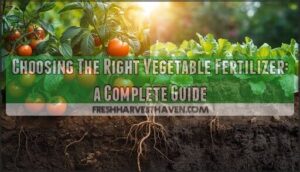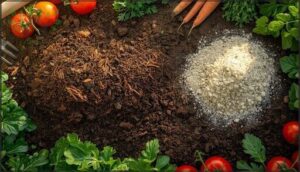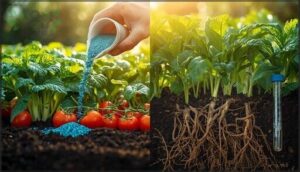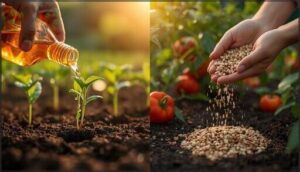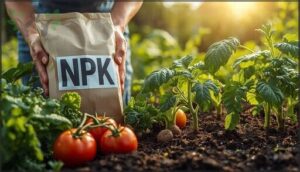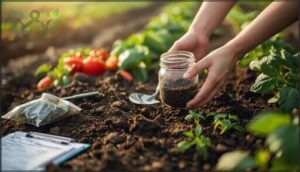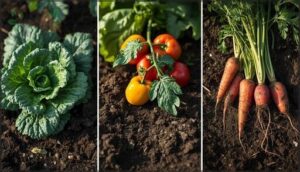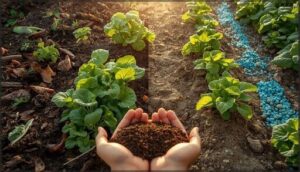This site is supported by our readers. We may earn a commission, at no cost to you, if you purchase through links.
Your tomato plants look healthy enough, but they’re not producing the way you hoped. The lettuce bolted early, and those peppers never quite reached full size. More often than not, the culprit isn’t water or sunlight—it’s what’s happening beneath the soil surface.
Vegetables are heavy feeders, and different crops pull different nutrients from the ground at different rates. Feed a nitrogen-heavy fertilizer to your tomatoes, and you’ll get lush foliage with few fruits. Shortchange your leafy greens on nitrogen, and they’ll stay stunted and bitter.
Choosing the right vegetable fertilizer means understanding what your plants actually need, when they need it, and how soil conditions affect every nutrient you add.
Table Of Contents
- Key Takeaways
- Key Nutrients for Healthy Vegetable Growth
- Types of Fertilizers for Vegetables
- Understanding NPK Ratios and Labels
- Conducting a Soil Test Before Fertilizing
- Choosing Fertilizer Based on Vegetable Type
- Organic Vs. Synthetic Fertilizers Compared
- Fertilizer Application Methods for Best Results
- Common Fertilizing Mistakes to Avoid
- Top 3 Fertilizers for Vegetable Gardens
- Sustainable and Safe Fertilizer Practices
- Frequently Asked Questions (FAQs)
- How do I choose the right fertilizer?
- How do I know if my vegetable garden needs fertilizer?
- What fertilizer should I use for fruiting plants?
- Which fertilizer is best for vegetables?
- Why is fertilizer important in a vegetable garden?
- What do you need to grow a vegetable garden?
- How to choose fertilizer for a vegetable garden?
- What is the 20/20/20 rule for fertilizer?
- When should I apply 10-10-10 fertilizer to my vegetable garden?
- What is the best fertilizer for vegetables?
- Conclusion
Key Takeaways
- Start with a soil test to identify exact nutrient deficiencies and pH imbalances before choosing any fertilizer, since up to 50% of nutrient availability depends on maintaining pH between 6.0 and 7.5.
- Match your NPK ratio to what you’re growing—leafy greens need nitrogen-heavy formulas like 12-4-8, while fruiting vegetables require more phosphorus and potassium in ratios closer to 8-16-16 as they flower.
- Don’t overlook micronutrients like zinc, iron, and calcium, which affect over 35% of soils and can reduce yields by 20-30% when deficient, even if your NPK levels look fine.
- Apply fertilizer in split applications timed to growth stages rather than all at once, since this method reduces nutrient waste by up to 25% while delivering nutrients exactly when plants need them most.
Key Nutrients for Healthy Vegetable Growth
Your vegetables need the right balance of nutrients to produce strong roots, lush leaves, and abundant harvests. While nitrogen, phosphorus, and potassium form the foundation of plant nutrition, other elements and soil conditions play equally important roles in what your plants can actually absorb.
Let’s break down the essential nutrients your garden needs and how they work together to keep your vegetables thriving.
Roles of Nitrogen, Phosphorus, and Potassium
Understanding plant nutrition starts with nitrogen, phosphorus, and potassium—your NPK ratio foundation. These nutrients work together through complex nutrient interactions to boost fertilizer optimization.
- Nitrogen cycling drives leafy growth and development, though crops generally recover only 42% of what you apply in irrigated systems
- Phosphorus uptake powers root development, flowering, and energy transfer through photosynthesis
- Potassium deficiency weakens drought tolerance and disease resistance, reducing overall vegetable quality
- Balanced applications prevent nitrogen-rich soils from limiting yields despite adequate supply
- Effective fertilizer use involves considering phosphorus sources to secure peak plant growth.
Importance of Micronutrients
While nitrogen, phosphorus, and potassium are important, micronutrients play an equally critical role in driving essential plant functions. Over 35% of Indian soils lack zinc, and iron deficiency affects an additional 11%, leading to symptoms like stunted growth and poor flowering, which can dramatically reduce yields. These issues can be identified through soil analysis before they severely impact your harvest.
| Micronutrient | Primary Role |
|---|---|
| Zinc | Enzyme activation, growth regulation |
| Iron | Chlorophyll production, photosynthesis |
| Calcium | Cell wall structure, disease resistance |
| Magnesium | Energy transfer, nutrient cycling |
| Molybdenum | Nitrogen fixation, crop enhancement |
Proper micronutrient management offers benefits that extend beyond yield. They are crucial in determining vegetable quality and, ultimately, your market returns. Soil health is closely tied to balanced plant nutrition, making fertilizer selection a task that requires precision rather than guesswork. Understanding the role of micronutrient supply is vital for maximizing crop yields and overall plant health.
How Soil PH Impacts Nutrient Uptake
Soil pH levels directly control nutrient solubility and uptake in your vegetables. Between pH 6.0 and 7.5, most nutrients remain chemically available. Below 5.5, acidic effects lock up phosphorus with aluminum while releasing toxic metals. Above 7.5, alkaline impacts bind phosphorus into insoluble calcium compounds.
Microbial activity peaks between pH 6 and 7, driving nutrient cycling. Without proper soil pH management, even well-chosen fertilizers won’t deliver their full potential to your plants.
Types of Fertilizers for Vegetables
When you’re standing in the garden center staring at rows of fertilizer bags, the choices can feel overwhelming. The good news is that most fertilizers fall into just a few basic categories, each with its own strengths and ideal uses.
Let’s break down the main types you’ll encounter so you can pick the right one for your vegetables.
Organic Fertilizers (Compost, Manure, Bone Meal)
You’ll find three powerhouse organic fertilizers that transform your vegetable garden naturally: compost, manure, and bone meal.
Compost enriches soil biota and organic matter, boosting soil carbon by over 30% at proper application rates. Manure benefits include substantial nitrogen, phosphorus, and potassium delivery. Bone meal uses center on phosphorus provision—raising soil phosphorus up to 31.75%—perfect for root development.
These organic fertilizers build lasting soil fertility while supporting sustainable growing practices.
Synthetic Fertilizers and Their Benefits
Synthetic fertilizers deliver concentrated nutrients that work fast—you’ll often see improved plant vigor within days. Their standardized formulas let you precisely target your vegetables’ needs at each growth stage.
- Fertilizer efficiency: Smaller quantities needed due to high nutrient concentration
- Crop yield: Nitrogen, phosphorus, and potassium applications boost yields by 10–32% on average
- Nutrient uptake: Rapid action fosters stronger, more uniform plant growth
- Soil conservation: Higher yields per acre reduce pressure on natural habitats
These formulations help you grow more food on less land.
Liquid Vs. Granular Fertilizers
Your choice between liquid and granular fertilizers shapes fertilizer efficiency and fertilizer cost in your vegetable garden. Liquid options deliver nutrients within hours, achieving up to 80% better absorption during early growth—ideal when application timing matters. Granular fertilizers release slowly over six to eight weeks, maintaining soil moisture-dependent feeding at 30–80% levels.
This table shows key differences for fertilizer application:
| Factor | Liquid | Granular |
|---|---|---|
| Nutrient Leaching Risk | Higher in sandy soil | Lower with coatings |
| Reapplication Frequency | Every 2–4 weeks | Once per season |
| Best Growth Phase | Seedling stage | Fruiting crops |
Understanding NPK Ratios and Labels
When you pick up a bag of fertilizer, those three numbers on the label aren’t random—they’re your roadmap to better vegetables. The NPK ratio tells you exactly what nutrients you’re adding to your soil and in what proportions.
Understanding these numbers helps you match the right fertilizer to what your plants actually need at each stage of growth.
What NPK Means for Vegetable Gardens
When you look at a fertilizer bag, those three numbers—like 10-10-10—aren’t random. They represent the NPK ratio, showing the percentage by weight of Nitrogen, Phosphorus, and Potassium in that exact order. Understanding this macronutrient role is the foundation of smart fertilizing.
Here’s what each one does for your vegetables:
- Nitrogen fuels leafy growth and chlorophyll production
- Phosphorus strengthens roots and aids flowering
- Potassium boosts disease resistance and water regulation
- NPK balance prevents nutrient deficiency and optimizes yield
Soil analysis reveals what your garden actually needs, guiding fertilizer timing and selection for healthier crops.
Matching NPK Ratios to Vegetable Needs
Different vegetables crave different nutrient combinations, and matching your NPK ratio to what you’re growing makes all the difference in harvest quality. Leafy greens like spinach thrive on nitrogen-heavy blends such as 12-4-8, pushing vigorous foliage. Root crops—carrots, potatoes—need phosphorus and potassium to shine, so reach for 5-10-30 ratios during tuber formation. Fruiting vegetables benefit from balanced early feeding, then shift to 8-16-16 as flowers appear.
| Vegetable Type | Recommended NPK Ratio |
|---|---|
| Leafy Greens | 12-4-8 or 20-10-10 |
| Root Crops | 5-10-30 or 10-20-20 |
| Fruiting Vegetables | 8-16-16 or 5-10-10 |
Adjusting fertilizer timing and formulation by growth stage boosts yields up to 18% and sharpens nutrient uptake efficiency.
Conducting a Soil Test Before Fertilizing
You can’t choose the right fertilizer without knowing what your soil already has. A soil test takes the guesswork out of feeding your vegetables and helps you avoid wasting time and money on nutrients your garden doesn’t need.
Here’s how to collect samples, read your results, and spot what’s missing.
How to Collect Soil Samples
Getting accurate soil testing and analysis starts with proper subsample collection. Using a soil probe, trowel, or auger, take 15–30 subsamples from sampling depths of 6 inches across your garden in a zig-zag pattern.
Mix them thoroughly in a clean bucket, removing stones and debris during soil preparation. This creates a representative composite sample that reflects your soil health, ensuring your compost and fertilizer decisions support maximum vegetable growth.
Interpreting Soil Test Results
Once your soil test report arrives, you’ll see nutrient levels and pH balance that guide your fertilizer calibration decisions. Soil testing and analysis reveals your garden’s true soil health through test interpretation. Here’s what matters most:
- Phosphorus below 10 ppm signals your vegetables will respond strongly to added fertilizer
- Potassium under 75 means supplemental K application boosts growth
- pH outside 6.0–7.0 limits nutrient availability by up to 50%
- Organic matter under 2% indicates poor nutrient-holding capacity
- Calcium below 200 ppm suggests high-demand crops need supplementation
These numbers transform soil analysis into actionable fertilizer plans.
Identifying Nutrient Deficiencies
Your soil test reveals deficiency signs that nutrient testing alone can’t always catch. Crop monitoring shows nitrogen-deficient leaves turning yellow, especially on older growth, which can reduce harvest by 30%. Phosphorus shortages stunt roots and cause purple leaf tips, cutting yields by up to 20%. Potassium problems appear as leaf-edge browning and weak disease resistance. Match these visual clues with soil analysis results for precise fertilizer adjustment.
| Nutrient | Visual Symptoms | Yield Impact |
|---|---|---|
| Nitrogen | Yellowing older leaves, stunted growth | 30%+ reduction |
| Phosphorus | Purple leaf tips, slow roots | Up to 20% loss |
| Potassium | Marginal browning, disease susceptibility | Significant decline |
Choosing Fertilizer Based on Vegetable Type
Not all vegetables eat the same way, and your fertilizer choice needs to match what each plant is trying to build. Leafy greens, fruiting crops, and root vegetables each pull different nutrients from the soil depending on whether they’re focused on leaves, flowers and fruit, or underground growth.
Here’s how to tailor your fertilizer to what you’re growing and when your plants need it most.
Leafy Greens Vs. Fruiting Vegetables
Your fertilizer strategy shifts depending on what you’re growing. Leafy greens thrive on higher nitrogen levels—think NPK ratios around 20-10-10—to fuel vigorous foliage growth.
Fruiting vegetables like tomatoes need more phosphorus and potassium, with ratios closer to 10-30-20, to support flowering and fruit yield. Too much nitrogen in your vegetable garden’s fruiting crops triggers excessive foliage at the expense of harvest timing and quality.
Root Crops and Their Nutrient Needs
Root crop nutrition centers on phosphorus and potassium rather than nitrogen—aim for NPK ratios like 5-10-10 to optimize underground yield without excessive foliage. Phosphorus deficiency can reduce root biomass by 25%, while nitrogen above 80 kg/ha actually lowers carrot and potato harvests.
Don’t overlook micronutrient deficiency: boron prevents internal browning in beets, and zinc assists proper root length.
Organic fertilizers like bone meal boost phosphorus availability when incorporated before planting.
Adjusting Fertilizer for Growth Stages
Beyond root formation, your plants shift what they need as they mature—that’s where growth stage fertilization comes in. Nutrient uptake rates peak differently across phases, so fertilizer timing matters for yield optimization.
Match fertilizer application to crop specific needs:
- Seedling/vegetative: High nitrogen promotes leaf expansion in tomatoes and broccoli
- Flowering: Increase phosphorus for fruit set—deficiency cuts yields 30%
- Fruiting: Boost potassium for fruit quality and size
- Adjust NPK ratio: Shift from nitrogen-heavy to balanced or potassium-focused formulas
Organic Vs. Synthetic Fertilizers Compared
Choosing between organic and synthetic fertilizers isn’t just about what works—it’s about what works best for your garden, your budget, and the land you’re working with. Both options will feed your vegetables, but they do it in different ways and come with their own trade-offs.
Let’s break down how these fertilizers compare across three key areas that matter most to gardeners.
Environmental Impact and Sustainability
Your choices reach far beyond your garden’s fence line. Synthetic and manure-based fertilizers together generate 2.6 gigatonnes of carbon emissions yearly—more than all aviation and shipping combined. Fertilizer use drives 84% of vegetable farming’s greenhouse emissions, while up to 80% of applied nutrients wash away, fueling water pollution and ecosystem damage.
Fertilizers generate more emissions than aviation and shipping combined, while most nutrients wash away as pollution
Sustainable practices like combining organic fertilizers with synthetics cut emissions by 28-35% and nitrogen leaching by 48%, protecting watersheds while building healthier soil for sustainable agriculture.
| Impact Category | Synthetic Fertilizers | Organic Fertilizers |
|---|---|---|
| Greenhouse Emissions | High N₂O output during production and after application | 75% of N₂O in vegetables; lower when combined with synthetics |
| Water Pollution | 40-80% nutrient loss to runoff; major eutrophication driver | Reduces nitrogen leaching 41-48% when blended |
| Soil Depletion | Depletes 60 kg P₂O₅, 101 kg K₂O per hectare annually | Increases soil organic carbon 12.5-18%; improves microbial activity |
Nutrient Release and Plant Uptake
The timeline of plant absorption separates these two approaches. Synthetic fertilizers deliver nitrogen, phosphorus, and potassium immediately—you’ll see results within days as plants rapidly uptake available nutrients. Organic options rely on soil microbes to break down materials over weeks or months, creating gradual nutrient cycling that matches natural uptake patterns. This difference in fertilizer efficiency directly impacts how you time applications and manage nutrient deficiencies throughout your growing season.
| Feature | Synthetic Fertilizers | Organic Fertilizers |
|---|---|---|
| Nutrient Release Speed | 80% nitrogen released within days; immediate plant response | 1-10% content released over weeks/months via microbial breakdown |
| Application Frequency | Up to 5 events per season; prone to leaching between doses | 3 applications sufficient; sustained availability reduces frequency |
| NPK Content & Uptake | 20-30% concentrated nutrients; rapid absorption but higher loss risk | Lower concentrations; slower but steadier plant absorption patterns |
Cost and Availability Considerations
Your wallet feels the difference between organic and synthetic options every season. Synthetic fertilizers cost $100–$300 per application for residential gardens, while organic alternatives range from $200–$500—nearly double for comparable coverage. Market trends show urea averaged $619 per ton in September 2025 (up 28% year-over-year), and custom NPK blends run $430–$550 per ton depending on your region.
| Cost Factor | Synthetic Fertilizers | Organic Fertilizers |
|---|---|---|
| Application Cost | $100–$300 per treatment | $200–$500 per treatment |
| Price Per Ton | $430–$619 average (NPK/urea) | Premium pricing over synthetics |
| Availability | Widely stocked; stable supply chains | Available but limited inventory |
| Regional Variance | Lower near production hubs | Higher in remote areas |
| 2025 Price Trend | 7–28% increases from tariffs/shortages | Rising demand drives costs up |
Supply chains remained mostly stable through mid-2025, though geopolitical tensions and trade restrictions created intermittent shortages. You’ll find synthetic options at most garden centers year-round, but organic fertilizers command premium prices due to sustainability demand. Check online inventory tools before shopping—regional price differences can save you 15–20% if you’re near shipping hubs or production facilities.
Fertilizer Application Methods for Best Results
Knowing which fertilizer to use is only half the battle—applying it correctly makes all the difference in your garden’s success. The method and timing you choose directly affect how well your vegetables absorb nutrients and how efficiently they grow.
Let’s look at the most effective application techniques and when to use them for maximum results.
Broadcasting, Side-Dressing, and Foliar Feeding
How you apply fertilizer matters just as much as what you use. Broadcasting spreads nutrients evenly across the soil surface but requires up to 50% more fertilizer to match the crop response you’ll get from targeted methods.
Side-dressing places nutrients directly near plant roots, dramatically improving soil uptake and fertilizer efficiency—you’ll often achieve similar yields with 25% less product.
Foliar feeding delivers nutrients straight through leaves, reaching efficiency levels of 95–100% for nitrogen compared to just 15–62% for soil applications.
Each fertilizing technique has its place, and understanding these fertilizer application methods helps you optimize nutrient delivery while minimizing waste.
Timing Fertilizer Applications
Your fertilizer schedules directly determine whether nutrients reach plants when they need them most. Split applications across three key periods—pre-planting, at planting, and post-emergence—prevent early leaching while avoiding nutrient deficiencies later.
Nitrogen usually shows its greatest effect within three to four weeks, so crop monitoring and soil testing help you time applications to match growth stages. Sandy soils demand more frequent fertilizing than clay due to faster leaching, making soil moisture tracking essential.
With fertigation systems, you’ll apply 20–40% of nutrients pre-plant and split the remainder throughout the season—this nutrient management strategy optimizes nutrient uptake while reducing waste.
Common Fertilizing Mistakes to Avoid
Even experienced gardeners can slip up in fertilizing vegetables. Small missteps—like adding too much, skipping important nutrients, or overlooking your soil’s pH—can quietly undermine months of careful work.
Here are three common mistakes you’ll want to steer clear of to keep your garden thriving.
Over-Fertilization and Its Signs
More isn’t always better for feeding your vegetables. Over-fertilization creates soil toxicity and nutrient imbalance, leading to fertilizer burn—those telltale brown, crispy leaf edges that appear within 48 hours of heavy application.
You’ll notice white salt crusts on your soil surface, wilting despite adequate moisture, and plant defoliation as leaves drop prematurely. These warning signs indicate you’ve crossed the line from nourishment to environmental damage.
Neglecting Micronutrients
While you’re watching for signs of over-fertilization, don’t overlook micronutrient deficiency—an equally damaging mistake. Zinc, iron, and calcium levels in vegetables have dropped markedly in recent decades, yet many gardeners focus solely on nitrogen, phosphorus, and potassium.
Soil testing reveals these hidden gaps, and foliar application can quickly correct deficiencies. Balanced fertilizer selection and crop rotation support long-term soil health and proper nutrient uptake for ideal plant nutrition management.
Ignoring Soil PH Adjustments
Even perfect fertilizer application techniques won’t help if your soil pH is off. When pH drops below 5.0, vegetable yields can fall by 50%, and nutrient imbalances become inevitable. Iron deficiency appears above 7.3 despite adequate soil levels, while aluminum toxicity strikes acidic soils.
Test your soil pH annually—this single soil test prevents fertilizer inefficiency and costly nutrient deficiencies that undermine your garden’s soil health and productivity.
Top 3 Fertilizers for Vegetable Gardens
You’ve learned the fundamentals of fertilizing your vegetable garden, and now it’s time to put that knowledge into action. Selecting the right fertilizer doesn’t have to be overwhelming when you focus on products that deliver results without unnecessary complexity.
Here are three reliable fertilizers that address different nutritional needs in your garden and work well for a variety of vegetables.
1. Organic Bulb Fertilizer Powder Mix
Dr. Earth’s organic bulb fertilizer powder mix brings something special to your vegetable garden with its 5-10-10 NPK ratio. This hand-crafted blend fosters plant development through both immediate and slow-release nutrient delivery while improving soil structure and health.
You’ll find it works well for root crops and bulb vegetables, targeting a pH of 6.5. It provides essential organic matter and compost-like benefits without the wait.
Best For: Home gardeners growing bulbs, tubers, or root vegetables who want an organic option that feeds plants while improving soil quality over time.
- Balanced 5-10-10 formula delivers the higher phosphorus and potassium levels that bulbs need for strong root development and vibrant blooms.
- Improves soil structure and water retention with 26.6% organic carbon, making it useful beyond just feeding plants.
- Safe around kids and pets, with a natural blend that won’t cause chemical buildup in your garden beds.
- The 4-pound bag might not go far if you’re working with a large garden or multiple raised beds.
- Results can vary depending on your existing soil conditions, so you might need a soil test first to get the most out of it.
- Some customers reported delivery issues like small holes in bags or longer-than-expected shipping times.
2. Organic Seaweed Kelp Plant Fertilizer Supplement
Greenleaf Nutrients’ SeaK for Plants Seaweed and Kelp Extract delivers over 18% soluble potassium alongside natural plant hormones that boost vegetable yields by roughly 15%. This OMRI-certified organic supplement enhances stress resistance and fruit quality through foliar feeding or soil application.
You’ll notice stronger root systems and improved disease tolerance. Studies show it increases crop vitamin C content by 18% while supporting sustainable gardening practices with minimal environmental impact.
Best For: Organic growers and gardeners who want a concentrated, water-soluble supplement to boost yields, improve fruit quality, and strengthen plant stress resistance across vegetables, flowers, and cannabis.
- Certified organic with impressive results—field studies show 15% average yield increases and measurable improvements in vitamin C, sugar content, and overall crop quality.
- Ultra-concentrated formula means 200g goes a long way, and it works in any growing system from soil to hydroponics with flexible application methods (foliar spray or root drench).
- Packed with natural plant hormones and over 60 trace minerals that enhance root development, disease resistance, and nutrient uptake without synthetic chemicals.
- Not registered as fertilizer in Washington, Oregon, or California, so growers in those states need to verify local regulations before using it.
- Powder can get sticky if you don’t store it properly in a cool, dry place with the container sealed tight.
- You’ll need to start at half strength and monitor pH after mixing, which adds an extra step compared to ready-to-use liquid fertilizers.
3. Finely Ground Egg Shell Powder
Pure eggshell powder packs 96-98% calcium carbonate—your secret weapon against blossom-end rot in tomatoes and peppers. This natural fertilizer raises soil pH while delivering essential calcium that fast-growing vegetables rapidly deplete.
Apply 300 kg/ha before planting or crush finely into planting holes for immediate uptake. You’ll strengthen cell walls, improve nutrient deficiencies, and transform kitchen waste into premium soil amendments that boost organic fertilizers’ effectiveness throughout your garden.
Best For: Organic gardeners fighting calcium deficiency in tomatoes, peppers, and eggplants who want a sustainable, chemical-free soil amendment.
- Delivers 96-98% pure calcium carbonate to prevent blossom-end rot and strengthen plant cell walls naturally.
- Made from sanitized, free-range eggshells with no antibiotics, hormones, or chemicals—completely safe for organic gardens.
- Finely ground texture allows quick soil incorporation and faster nutrient release compared to coarser alternatives.
- Won’t dissolve easily in water or milk, limiting application methods for some gardeners.
- The ultra-fine grind may be too powdery for gardeners who prefer coarser textures for spreading or composting.
- At $39.88 per pound, it’s pricier than making your own eggshell powder at home.
Sustainable and Safe Fertilizer Practices
Using fertilizer the right way means more than just feeding your plants—it’s about protecting your soil, your family, and the environment around you. Smart fertilizer practices help you grow healthier vegetables while reducing waste and runoff that can harm local waterways.
Let’s look at three key ways you can make your fertilizing routine both safer and more sustainable.
Reducing Environmental Impact
You can markedly cut your garden’s environmental footprint by adopting eco-friendly fertilizers and sustainable practices. Precision agriculture technologies and enhanced-efficiency fertilizers reduce nitrous oxide emissions by up to 24% while cutting nitrate leaching nearly 29%.
Cover crops slash nitrogen leaching by 60%, making them powerful allies in environmental conservation. Organic fertilizers, when properly composted, support ecosystems management without harmful synthetic additives.
These green technologies transform sustainable gardening practices into real climate action.
Safe Storage and Handling Tips
When storing fertilizer, you’ll want to keep it in a secure, climate-controlled space between 5°C and 30°C—away from food, pesticides, and moisture.
Always wear nitrile gloves and a particle mask during handling to avoid skin reactions and respiratory irritation.
Label containers with purchase dates, stack no more than three sacks indoors, and store everything upright on shelves.
Proper storage methods and handling precautions reduce spill response incidents and chemical hazards by up to 80%.
Integrating Compost and Green Manures
You can enrich your soil and slash synthetic fertilizer use by layering in compost and planting green manure crops between harvests. Compost benefits include boosting soil nitrogen by over 200%, while green manure delivers a microbial boost—raising enzyme activity up to 173%.
Together, these organic fertilizers improve nutrient availability, strengthen soil health, and build organic matter that keeps your vegetable beds thriving season after season.
Frequently Asked Questions (FAQs)
How do I choose the right fertilizer?
Don’t put all your eggs in one basket—choosing the right fertilizer means considering plant-specific needs, soil testing importance, organic vs synthetic options, budget considerations, and long-term effects for healthy vegetable gardens.
How do I know if my vegetable garden needs fertilizer?
Look for yellowing leaves, stunted growth, or poor fruiting—classic signs of nutrient deficiencies.
A soil test reveals exact fertility levels and NPK ratios, helping you spot problems before yields drop by 30–50%.
What fertilizer should I use for fruiting plants?
Fruiting vegetables thrive with higher phosphorus and potassium ratios—think 10-20-10 or 2-8-4 NPK formulations. These organic fertilizers and synthetic options strengthen flowering, boost fruit set, and improve overall yield when applied during bloom and fruit development stages.
Which fertilizer is best for vegetables?
The answer depends on your soil composition and plant stage. Different vegetable gardens need specific fertilizer types—organic fertilizers and synthetic options work differently. Soil tests reveal nutrient deficiencies, guiding fertilizer selection through proper application methods.
Why is fertilizer important in a vegetable garden?
Fertilizer replenishes soil fertility, prevents nutrient deficiencies, and boosts both yield and quality in your vegetable garden.
It fosters healthy plant growth while maintaining soil health when applied responsibly, minimizing environmental impact through sustainable practices.
What do you need to grow a vegetable garden?
Your vegetable garden needs several essentials: adequate sunlight, consistent water availability, healthy soil drainage, proper space planning, and effective pest control.
Start with a soil test to assess soil fertility, soil health, and any nutrient deficiencies.
How to choose fertilizer for a vegetable garden?
Start with a soil test to identify specific deficiencies in your vegetable garden.
Match fertilizer ratios to crop needs, weigh organic fertilizers against synthetics, factor budget considerations, and plan for local availability and container gardening requirements.
What is the 20/20/20 rule for fertilizer?
Think of it as equal parts harmony: the 20/20/20 rule means your fertilizer delivers 20% nitrogen, 20% phosphorus, and 20% potassium—perfect NPK balance for supporting vegetable garden growth stages.
When should I apply 10-10-10 fertilizer to my vegetable garden?
Apply 10-10-10 fertilizer in spring when soil reaches 55°F, then side-dress every 3-4 weeks through early summer.
Stop fertilizing six to eight weeks before frost to avoid cold damage and nutrient runoff.
What is the best fertilizer for vegetables?
Your garden’s success hinges on fertilizer selection that balances nutrient availability with plant-specific fertilization needs. Organic vs synthetic fertilizers each offer advantages—organic builds soil while synthetic provides quick results. Cost effectiveness matters too.
Conclusion
Next season’s harvest is being shaped right now—by the decisions you make in your soil today. Choosing the right vegetable fertilizer isn’t about following a one-size-fits-all formula. It’s about reading your plants, testing your ground, and matching nutrients to what’s actually missing.
Start with a soil test, match your amendments to your crops’ growth stages, and watch those struggling plants transform into the productive garden you’ve been working toward all along.
- https://www.sciencedirect.com/science/article/pii/S0048969724021594
- https://www.maxapress.com/article/doi/10.48130/tia-0024-0029
- https://pmc.ncbi.nlm.nih.gov/articles/PMC7954289/
- https://acornhorticulture.com/organic-vs-synthetic-fertilisers-in-indoor-gardening-pros-and-cons/
- https://www.canr.msu.edu/resources/fertilizer-cost-comparison-tool-vegetables

